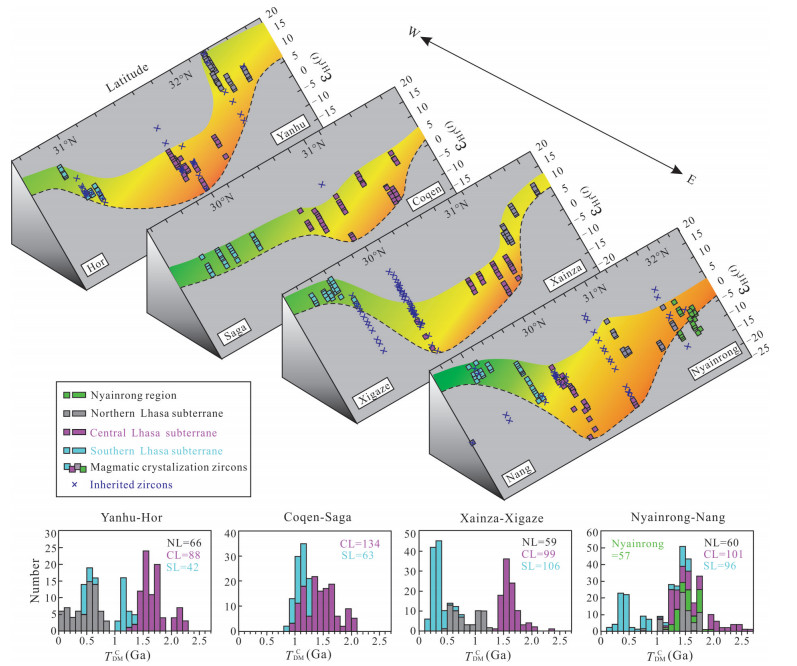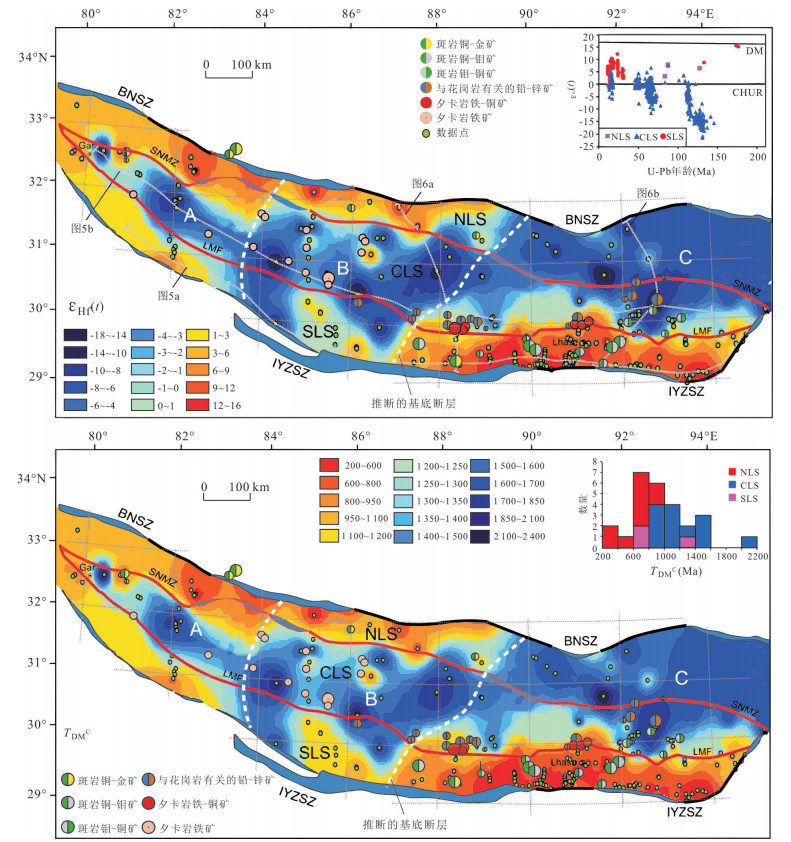Growth and Evolution of Crust of Tibetan Plateau from Perspective of Magmatic Rocks
-
摘要: 青藏巨厚陆壳的性质和形成机制,是重要的科学问题.通过对青藏岩浆岩,特别是其Nd、Hf同位素的研究,证明青藏高原并存着新生地壳和再循环地壳两类地壳.地壳的结构和属性对成矿矿种、矿床类型和分布有重要的控制作用.青藏巨厚地壳是由两种机制(构造加厚;地幔物质通过岩浆作用注入加厚)共同造成的,二者贡献比例约6:4.地壳增厚主要发生在50~25 Ma期间.大陆碰撞带是造成地壳净生长的重要构造部位.Abstract: The nature of the Tibetan extremely thick crust and its thickening mechanism are important scientific problems. According to the investigation of igneous rocks,especially Nd and Hf isotope studies,it proved the coexistence of two types of crust (juvenile and reworked) in the Tibetan Plateau,which controls the distribution of different types of ore deposits. The Tibetan crustal thickening was made by both tectonic compression and the input of mantle components carried by magmatism. The timing of the Tibetan crustal thickening was likely in the period of 50-25 Ma.Continental collision zones may be sites of net crustal growth through process of syncollisional magmatism.
-
图 1 冈底斯带花岗岩及其他岩浆岩的εNd(t)⁃87Sr/86Sr(i)图
Fig. 1. Plot of εNd(t) versus 87Sr/86Sr(i) of granitoid and other igneous rocks in the Gangdese, Tibet
图 2 拉萨地块4条南北向取样路线位置和中生代-古近纪岩浆岩锆石U⁃Pb年龄分布
Fig. 2. Sketch map showing the location of four north⁃south sampling traverses and isotope ages by situ zircon U⁃Pb dating of Mesozoic⁃Early Tertiary magmatic rocks in the Lhasa block
图 3 拉萨地块中生代-古近纪岩浆岩锆石εHf(t)值的范围与空间分布及Hf地壳模式年龄(TDMC)频率
Fig. 3. The range and spatial distribution of εHf(t) values, and the histograms of Hf crustal model ages (TDMC) of zircons from the Mesozoic–Early Tertiary magmatic rocks in the Lhasa block
图 4 拉萨地块两类地壳(新生地壳与再循环地壳)分布简图
Fig. 4. Sketch map showing the distribution of two types of crust (juvenile and reworked crust) of the Lhasa block
图 5 (a) 拉萨地块中生代-新生代花岗岩类与长英质火山岩锆石εHf(t)等值线空间变化图; (b) Hf地壳模式年龄(TDMc)等值线图
Fig. 5. (a) Hf isotope contour map showing the spatial variation of zircon εHf(t) values; (b) contour map of the zircon Hf crustal model ages (TDMc) for the Mesozoic⁃Cenozoic granitoid rocks and felsic volcanic rocks in the Lhasa block
-
Altherton, M. P., Petford, N., 1993. Generation of Sodium-Rich Magmas from Newly Underplated Basaltic Crust. Nature, 362(6416):144-146. https://doi.org/10.1038/362144a0 Argand, E., 1924. La Tectonique de Asie. 13th International Geology Congress, 7:171. Chung, S. L., Liu, D. Y., Ji, J. Q., et al., 2003. Adakites from Continental Collision Zones:Melting of Thickened Lower Crust beneath Southern Tibet. Geology, 31(11):1021. https://doi.org/10.1130/g19796.1 Condie, K.C., 1982. Plate Tectonics and Crustal Evolution. Pergamon, New York. Defant, M. J., Drummond, M. S., 1990. Derivation of Some Modern Arc Magmas by Melting of Young Subducted Lithosphere. Nature, 347(6294):662-665. https://doi.org/10.1038/347662a0 Deng, J.F., Luo, Z.H., Su, S.G., et al., 2004. Petrogenesis, Tectonic Environment and Metalogenesis. Geological Publishing House, Beijing (in Chinese). Deng, J.F., Mo, X.X., Zhao, H.L., et al., 1998. Crust-Mantle Materials and Deep Processes. Earth Science Frontiers, 5(3):67-75 (in Chinese with English abstract). Deng, J. F., Mo, X. X., Zhao, H. L., et al., 2004. A New Model for the Dynamic Evolution of Chinese Lithosphere:'Continental Roots-Plume Tectonics'. Earth-Science Reviews, 65(3/4):223-275. https://doi.org/10.1016/j.earscirev.2003.08.001 Deng, J.F., Zhao, H.L., Mo, X., et al., 1996. Continental Roots-Plume Tectonics: A Key to Continental Geodynamics. Geological Publishing House, Beijing (in Chinese with English abstract). DePaolo, D. J., 1981. A Neodymium and Strontium Isotopic Study of the Mesozoic Calc-Alkaline Granitic Batholiths of the Sierra Nevada and Peninsular Ranges, California. Journal of Geophysical Research: Solid Earth, 86(B11):10470-10488. https://doi.org/10.1029/jb086ib11p10470 DePaolo, D. J., 1985. Isotopic Studies of Processes in Mafic Magma Chambers:I. The Kiglapait Intrusion, Labrador. Journal of Petrology, 26(4):925-951. https://doi.org/10.1093/petrology/26.4.925 DePaolo, D. J., Perry, F. V., Baldridge, W. S., 1992. Crustal versus Mantle Sources of Granitic Magmas:A Two-Parameter Model Based on Nd Isotopic Studies. Earth and Environmental Science Transactions of the Royal Society of Edinburgh, 83(1/2):439-446. https://doi.org/10.1017/s0263593300008117 Dewey, J. F., Bird, J. M., 1970. Mountain Belts and the New Global Tectonics. Journal of Geophysical Research, 75(14):2625-2647. https://doi.org/10.1029/jb075i014p02625 Dewey, J. F., Burke, K. C. A., 1973. Tibetan, Variscan, and Precambrian Basement Reactivation:Products of Continental Collision. The Journal of Geology, 81(6):683-692. https://doi.org/10.1086/627920 Didier, J., Baibarin, B., 1991. Enclaves and Granite Petrology. Elsevier, Amsterdam. Dong, G. C., 2002. Linzizong Volcanic Rocks in Linzhou Basin, Tibet and Implications for India-Asia Continental Collision(Dissertation). China University of Geosciences, Beijing(in Chinese with English abstract). Dong, G. C., Mo, X. X., Zhao, Z. D., et al., 2005. Geochronologic Constraints on the Magmatic Underplating of the Gangdisê Belt in the India-Eurasia Collision:Evidence of SHRIMP Ⅱ Zircon U-Pb Dating. Acta Geologica Sinica-English Edition, 79(6):787-794. https://doi.org/10.1111/j.1755-6724.2005.tb00933.x Dong, G.C., Mo, X.X., Zhao, Z.D., et al., 2006. Magma Mixing in the Middle Part of the Gangdese Magmatic Belt:Evidences from Granitoid Complex. Acta Petrologica Sinica, 22(5):535-544 (in Chinese with English abstract). http://en.cnki.com.cn/Article_en/CJFDTOTAL-YSXB200604007.htm Dong, G.C., Mo, X.X., Zhao, Z.D., et al., 2008. Gabbros from Southern Gangdese:Implication for Mass Exchange between Mantle and Crust. Acta Petrologica Sinica, 24(2):203-210 (in Chinese with English abstract). http://cn.bing.com/academic/profile?id=feaad244e0a720e6bbd0d4aced09814b&encoded=0&v=paper_preview&mkt=zh-cn Dong, S.B., 1999. Some Discussion on the Recent Development of Granite Petrogenesis. In: Dong, S.B., ed., Collected Works of Dong Shenbao. Peking University Press, Beijing, 246-325(in Chinese). England, P., McKenzie, D., 1982. A Thin Viscous Sheet Model for Continental Deformation. Geophysical Journal International, 70(2):295-321. https://doi.org/10.1111/j.1365-246x.1982.tb04969.x England, P., Houseman, G., 1989. Extension during Continental Convergence, with Application to the Tibetan Plateau. Journal of Geophysical Research, 94(B12):17561. https://doi.org/10.1029/jb094ib12p17561 Flowerdew, M. J., Chew, D. M., Daly, J. S., et al., 2009. Hidden Archaean and Palaeoproterozoic Crust in NW Ireland? Evidence from Zircon Hf Isotopic Data from Granitoid Intrusions. Geological Magazine, 146(6):903-916. https://doi.org/10.1017/s0016756809990227 Griffin, W. L., Wang, X., Jackson, S. E., et al., 2002. Zircon Chemistry and Magma Mixing, SE China:In-Situ Analysis of Hf Isotopes, Tonglu and Pingtan Igneous Complexes. Lithos, 61(3/4):237-269. https://doi.org/10.1016/s0024-4937(02)00082-8 Guynn, J. H., Kapp, P., Pullen, A., et al., 2006. Tibetan Basement Rocks near Amdo Reveal "Missing" Mesozoic Tectonism along the Bangong Suture, Central Tibet. Geology, 34(6):505. https://doi.org/10.1130/g22453.1 Hou, Z. Q., Gao, Y. F., Qu, X. M., et al., 2004. Origin of Adakitic Intrusives Generated during Mid-Miocene East-west Extension in Southern Tibet. Earth and Planetary Science Letters, 220(1/2):139-155. https://doi.org/10.1016/s0012-821x(04)00007-x Hou, Z. Q., Duan, L. F., Lu, Y. J., et al., 2015. Lithospheric Architecture of the Lhasa Terrane and Its Control on Ore Deposits in the Himalayan-Tibetan Orogen. Economic Geology, 110(6):1541-1575. https://doi.org/10.2113/econgeo.110.6.1541 Hou, Z.Q., Wang, T., 2018. Isotopic Mapping and Deep Material Probing (Ⅱ):Imaging Crustal Architecture and Its Control on Mineral Systems. Earth Science Frontiers, 25(6):20-41 (in Chinese with English abstract). Hou, Z. Q., Zheng, Y. C., Yang, Z. M., et al., 2013. Contribution of Mantle Components within Juvenile Lower-Crust to Collisional Zone Porphyry Cu Systems in Tibet. Mineralium Deposita, 48(2):173-192. https://doi.org/10.1007/s00126-012-0415-6 Huppert, H. E., Sparks, R. S. J., 1988. The Generation of Granitic Magmas by Intrusion of Basalt into Continental Crust. Journal of Petrology, 29(3):599-624. https://doi.org/10.1093/petrology/29.3.599 Jahn, B. M., Wu, F. Y., Chen, B., 2000. Massive Granitoid Generation in Central Asia:Nd Isotope Evidence and Implication for Continental Growth in the Phanerozoic. Episodes, 23(2):82-92. https://doi.org/10.18814/epiiugs/2000/v23i2/001 Jiang, W., Mo, X., Zhao, C., et al., 1999. Geochemical Characteristics of Granites and Their Micromaficenclaves in Central Gangdese in Qinghai-Xizang (Tibet) Plateau. Acta Petrologica Sinica, 15 (1):89-97(in Chinese with English abstract). Kay, R. W., 1978. Aleutian Magnesian Andesites:Melts from Subducted Pacific Ocean Crust. Journal of Volcanology and Geothermal Research, 4(1/2):117-132. https://doi.org/10.1016/0377-0273(78)90032-x Kemp, A. I. S., Hawkesworth, C. J., Paterson, B. A., et al., 2006. Episodic Growth of the Gondwana Supercontinent from Hafnium and Oxygen Isotopes in Zircon. Nature, 439(7076):580-583. https://doi.org/10.1038/nature04505 Kind, R., Ni, J., Zhao, W., et al., 1996. Evidence from Earthquake Data for a Partially Molten Crustal Layer in Southern Tibet. Science, 274(5293):1692-1694. https://doi.org/10.1126/science.274.5293.1692 Liu, C. D., Mo, X. X., Luo, Z. H., et al., 2004. Mixing Events between the Crust- and Mantle-Derived Magmas in Eastern Kunlun:Evidence from Zircon SHRIMP Ⅱ Chronology. Chinese Science Bulletin, 49(8):828-834. https://doi.org/10.1007/bf02889756 Ma, Q.Z., 2016.Summary and Current Status of the Research Models for the Tibetan Plateau Uplift. Open Journal of Nature Science, 4(2):229-241 (in Chinese with English abstract). doi: 10.12677/OJNS.2016.42028 McKenzie, D., Priestley, K., 2008. The Influence of Lithospheric Thickness Variations on Continental Evolution. Lithos, 102(1/2):1-11. https://doi.org/10.1016/j.lithos.2007.05.005 Mo, X., Zhao, Z., Zhou, S., et al., 2002. Evidence for Timing of the Initiation of India-Asia Collision from Igneous Rocks in Tibet. AGU Fall Meeting Abstracts. 83(47): F1003, S62B-1201. Mo, X., Zhao, Z. D., Deng, J. F., et al., 2003. Volcanism in Response to India-Asia collision. Earth-Science Frontiers, 10(3):135-148 (in Chinese with English abstract). http://www.wanfangdata.com.cn/details/detail.do?_type=perio&id=7b458230acbbc30e296dc330514aaf04 Mo, X. X., Dong, G. C., Zhao, Z. D., et al., 2005. Timing of Magma Mixing in the Gangdisê Magmatic Belt during the India-Asia Collision:Zircon SHRIMP U-Pb Dating. Acta Geologica Sinica(English Edition), 79(1):66-76. https://doi.org/10.1111/j.1755-6724.2005.tb00868.x Mo, X., Dong, G.C., Zhao, Z.D., et al., 2005. Spatial and Temporal Distribution and Characteristics of Granitoids in the Gangdese, Tibet and Implications for Crustal Growth and Evolution. Geological Journal of China Universities, 11(3):281-290 (in Chinese with English abstract). https://www.zhangqiaokeyan.com/academic-journal-cn_geological-journal-china-universities_thesis/0201253567196.html Mo, X., Zhao, Z., Deng, J., et al., 2006. Petrology and Geochemistry of Postcollisional Volcanic Rocks from the Tibetan Plateau: Implications for Lithosphere Heterogeneity and Collision-Induced Asthenospheric Mantle Flow. In: Dilek, Y., Pavlides, S., eds., Postcollisional Tectonics and Magmatism in the Mediterranean Region and Asia. Geological Society of America Special Paper 409, New York, 507-530. Mo, X. X., Hou, Z. Q., Niu, Y. L., et al., 2007. Mantle Contributions to Crustal Thickening during Continental Collision:Evidence from Cenozoic Igneous Rocks in Southern Tibet. Lithos, 96(1/2):225-242. https://doi.org/10.1016/j.lithos.2006.10.005 Mo, X. X., Niu, Y. L., Dong, G. C., et al., 2008. Contribution of Syncollisional Felsic Magmatism to Continental Crust Growth:A Case Study of the Paleogene Linzizong Volcanic Succession in Southern Tibet. Chemical Geology, 250(1/2/3/4):49-67. https://doi.org/10.1016/j.chemgeo.2008.02.003 Mo, X.X., Zhao, Z., Yu, X., et al., 2009. Cenozoic Collision-Postcollisional Igneous Rocks in the Tibetan Plateau. Geological Publishing House, Beijing (in Chinese). Mo, X.X., 2011. Magmaand Magmatic Rocks:A Lithoprobe to the Deep Earth and Records of the Earth Evolution. ChineseJournal of Nature, 33(5):255-259 (in Chinese withEnglish abstract). Mo, X., 2019. Magmatism and Deep Geological Process. Earth Science, 44(5):1487-1493 (in Chinese with English abstract). http://en.cnki.com.cn/Article_en/CJFDTotal-DQKX201905007.htm Molnar, P., Houseman, G. A., Conrad, C. P., 1998. Rayleigh-Taylor Instability and Convective Thinning of Mechanically Thickened Lithosphere:Effects of Non-Linear Viscosity Decreasing Exponentially with Depth and of Horizontal Shortening of the Layer. Geophysical Journal International, 133(3):568-584. https://doi.org/10.1046/j.1365-246x.1998.00510.x Nelson, K. D., Zhao, W., Brown, L. D., et al., 1996. Partially Molten Middle Crust beneath Southern Tibet:Synthesis of Project INDEPTH Results. Science, 274(5293):1684-1688. https://doi.org/10.1126/science.274.5293.1684 Niu, Y. L., Zhao, Z. D., Zhu, D. C., et al., 2013. Continental Collision Zones are Primary Sites for Net Continental Crust Growth:A Testable Hypothesis. Earth-Science Reviews, 127:96-110. https://doi.org/10.1016/j.earscirev. 2013.09.004 doi: 10.1016/j.earscirev.2013.09.004 Owens, T. J., Zandt, G., 1997. Implications of Crustal Property Variations for Models of Tibetan Plateau Evolution. Nature, 387(6628):37-43. https://doi.org/10.1038/387037a0 Pan, G.T., Mo, X., Hou, Z.Q., et al., 2006.Spatio-Temporal Structure and Evolution of the Gangdise Orogenic Belt. Acta Petrologica Sinica, 22 (3):521-533 (in Chinese with English abstract). Petford, N., Atherton, M., 1996. Na-Rich Partial Melts from Newly Underplated Basaltic Crust:The Cordillera Blanca Batholith, Peru. Journal of Petrology, 37(6):1491-1521. https://doi.org/10.1093/petrology/37.6.1491 Powell, C. M., 1986. Continental Underplating Model for the Rise of the Tibetan Plateau. Earth and Planetary Science Letters, 81(1):79-94. https://doi.org/10.1016/0012-821x(86)90102-0 Profeta, L., Ducea, M. N., Chapman, J. B., et al., 2015. Quantifying Crustal Thickness over Time in Magmatic Arcs. Scientific Reports, 5(1):7786. https://doi.org/10.1038/srep17786 Rapp, R. P., Shimizu, N., Norman, M. D., et al., 1999. Reaction between Slab-Derived Melts and Peridotite in the Mantle Wedge:Experimental Constraints at 3.8 GPa. Chemical Geology, 160(4):335-356. https://doi.org/10.1016/s0009-2541(99)00106-0 Rudnick, R. L., Fountain, D. M., 1995. Nature and Composition of the Continental Crust:A Lower Crustal Perspective. Reviews of Geophysics, 33(3):267. https://doi.org/10.1029/95rg01302 Rudnick, R.L., Gao, S., 2003. Composition of the Continental Crust. Treatise on Geochemistry, 3:1-64. http://cn.bing.com/academic/profile?id=e4e7bfe526622b0f272f13e9a0ae5c2c&encoded=0&v=paper_preview&mkt=zh-cn Samson, S. D., McClelland, W. C., Patchett, P. J., et al., 1989. Evidence from Neodymium Isotopes for Mantle Contributions to Phanerozoic Crustal Genesis in the Canadian Cordillera. Nature, 337(6209):705-709. https://doi.org/10.1038/337705a0 Schmitz, M., 1994. A Balanced Model of the Southern Central Andes. Tectonics, 13(2):484-492. https://doi.org/10.1029/93tc02232 Vernon, R. H., 1984. Microgranitoid Enclaves in Granites-Globules of Hybrid Magma Quenched in a Plutonic Environment. Nature, 309(5967):438-439. https://doi.org/10.1038/309438a0 Wyllie, P. J., 1977. Crustal Anatexis:An Experimental Review. Tectonophysics, 43(1/2):41-71. https://doi.org/10.1016/0040-1951(77)90005-1 Wyllie, P.J., 1984. Constraints Imposed by Experimental Petrology on Possible and Impossible Magma Sources and Products. Philosophical Transactions of the Royal Society of London Series A, Mathematical and Physical Sciences, 310(1514):439-456. https://doi.org/10.1098/rsta.1984.0003 Xiong, S.Q., Zhou, F.H., Yao, Z.X., et al., 2001. Aeromagnetic Survey of Central and Western Tibetan Plateau. Geological Publishing House, Beijing, 75-87 (in Chinese). Yin, A., Harrison, T. M., 2000. Geologic Evolution of the Himalayan-Tibetan Orogen. Annual Review of Earth and Planetary Sciences, 28(1):211-280. https://doi.org/10.1146/annurev.earth.28.1.211 Zhao, W. L., Morgan, W. J., 1987. Injection of Indian Crust into Tibetan Lower Crust:A Two-Dimensional Finite Element Model Study. Tectonics, 6(4):489-504. https://doi.org/10.1029/tc006i004p00489 Zhou, S., Mo, X. X., Dong, G. C., et al., 2004. 40Ar-39Ar Geochronology of Cenozoic Linzizong Volcanic Rocks from Linzhou Basin, Tibet, China, and Their Geological Implications. Chinese Science Bulletin, 49(18):1970-1979. https://doi.org/10.1007/bf03184291 Zhu, D. C., Mo, X. X., Niu, Y. L., et al., 2009. Geochemical Investigation of Early Cretaceous Igneous Rocks along an East-West Traverse Throughout the Central Lhasa Terrane, Tibet. Chemical Geology, 268(3/4):298-312. https://doi.org/10.1016/j.chemgeo.2009.09.008 Zhu, D. C., Wang, Q., Cawood, P. A., et al., 2017. Raising the Gangdese Mountains in Southern Tibet. Journal of Geophysical Research: Solid Earth, 122(1):214-223. https://doi.org/10.1002/2016jb013508 Zhu, D. C., Zhao, Z. D., Niu, Y. L., et al., 2011. The Lhasa Terrane:Record of a Microcontinent and Its Histories of Drift and Growth. Earth and Planetary Science Letters, 301(1/2):241-255. https://doi.org/10.1016/j.epsl.2010.11.005 邓晋福, 罗照华, 苏尚国, 等, 2004.岩石成因、构造环境与成矿作用.北京: 地质出版社. 邓晋福, 莫宣学, 赵海玲, 等, 1998.壳幔物质与深部过程.地学前缘, 5(3):67-75. doi: 10.3321/j.issn:1005-2321.1998.03.006 邓晋福, 赵海玲, 莫宣学, 等, 1996.中国大陆根-柱构造-大陆动力学的钥匙.北京: 地质出版社. 董国臣, 莫宣学, 赵志丹, 等, 2008.西藏冈底斯南带辉长岩及其所反映的壳幔作用信息.岩石学报, 24(2):203-210. http://www.wanfangdata.com.cn/details/detail.do?_type=perio&id=ysxb98200802002 董国臣, 2002.西藏林周盆地林子宗火山岩及其所含的印度-亚洲碰撞信息(博士学位论文).北京: 中国地质大学. 董申保, 1999. Some Discussion on the Recent Development of Granite Petrogenesis.见: 董申保, 著, 董申保文集.北京: 北京大学出版社, 246-325. 董国臣, 莫宣学, 赵志丹, 等, 2006.冈底斯岩浆带中段岩浆混合作用: 来自花岗杂岩的证据, 岩石学报, 22(5): 535-544. 侯增谦, 王涛, 2018.同位素填图与深部物质探测(Ⅱ):揭示地壳三维架构与区域成矿规律.地学前缘, 25(6):20-41. http://www.cnki.com.cn/Article/CJFDTotal-DXQY201806004.htm 江万, 莫宣学, 赵崇贺, 等, 1999.青藏高原冈底斯带中段花岗岩及其中铁镁质微粒包体地球化学特征.岩石学报, 15(1):89-97. http://www.wanfangdata.com.cn/details/detail.do?_type=perio&id=ysxb98199901010 马钦忠, 2016.青藏高原隆生演化变形模式研究进展.自然科学, 4(2):229-241. http://www.wanfangdata.com.cn/details/detail.do?_type=perio&id=HANS201703027646 莫宣学, 2011.岩浆与岩浆岩:地球深部"探针"与演化记录.自然杂志, 33(5):255-259. 莫宣学, 2019.岩浆作用与地球深部过程.地球科学, 44(5):1487-1493. doi: 10.3799/dqkx.2019.972 莫宣学, 董国臣, 赵志丹, 等, 2005.西藏冈底斯带花岗岩的时空分布特征及地壳生长演化信息高校地质学报, 11(3): 281-290. 莫宣学, 赵志丹, 邓晋福, 等, 2003.印度-亚洲大陆主碰撞过程的火山作用响应.地学前缘, 10(3):135-148. doi: 10.3321/j.issn:1005-2321.2003.03.013 莫宣学, 赵志丹, 喻学惠, 等, 2009.青藏高原新生代碰撞-后碰撞火成岩.北京: 地质出版社. 潘桂棠, 莫宣学, 侯增谦, 等, 2006.冈底斯造山带的时空结构及演化.岩石学报, 22(3):521-533. http://www.wanfangdata.com.cn/details/detail.do?_type=perio&id=ysxb98200603001 熊盛青, 周伏洪, 姚正煦, 等, 2001.青藏高原中西部航磁调査.北京:地质出版社, 75-87. -










 下载:
下载:





